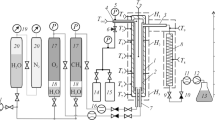Abstract
A well-stirred reactor for phenol and acetic acid oxidation in supercritical water is considered. A mathematical model of an adiabatic reactor is formulated. A numerical algorithm for solving the model equations using the homotopy method is developed. The model takes into account specific features of processes under supercritical conditions, namely, the changes in the thermodynamic properties (enthalpy, heat capacity, and critical parameters) of mixtures with a change in pressure and temperature. The thermodynamic properties are calculated by methods of nonideal thermodynamics. It is shown that there is a multiplicity of steady-state solutions at various reactor performances. The results of numerical analysis of the effect of the inlet flow temperature, the amount of methanol (fuel) fed, and the total pressure on the reactor performance are presented.
Similar content being viewed by others
Abbreviations
- C i :
-
concentration of the ith component, g-mol/l
- c p :
-
specific heat of the mixture, J/(mol K)
- Fi :
-
function defined by Eq. (7)
- \(\bar H_i \) :
-
partial molar enthalpy of the ith component, J/mol
- H m :
-
enthalpy of the mixture, J/mol
- N:
-
total molar flow rate, g-mol/s
- N r :
-
number of chemical reactions
- N s :
-
number of the components of the reaction mixture
- n i :
-
molar flow rate of the ith component, g-mol/s
- P:
-
pressure, MPa
- Q heat :
-
heat flow rate required for heating the initial mixture from the temperature T 0 to the temperature T ad, J/s
- Q react :
-
heat flow rate produced in the exothermic reaction, J/s
- q i :
-
rate of formation or consumption of the ith component, g-mol/(l s)
- R:
-
rate of acetic acid oxidation by reaction (2), g-mol/(l s)
- R 1 :
-
rate of phenol oxidation by reaction (1), g-mol/(l s)
- R 2 :
-
rate of phenol oxidation by reaction (3), g-mol/(l s)
- T:
-
temperature, K
- V m :
-
molar volume of the mixture, l/mol
- V R :
-
reactor volume, 1
- y:
-
vector of mole fractions of components of dimension N s
- y i :
-
mole fraction of the ith component
- γ:
-
coefficient of change in the molar flow rate in the reactor
- ΔT ad :
-
temperature difference due to adiabatic heating of the reaction mixture
- τ:
-
conditional contact time, (l s)/g-mol
- Ac:
-
acetic acid
- ad:
-
adiabatic
- cr:
-
critical
- Me:
-
methanol
- m:
-
mixture
- out:
-
reactor outlet
- Ph:
-
phenol
- 0:
-
reactor inlet
References
Li, L., Chen, P., and Gloyna, E.F., Generalized Kinetic Model for Wet Oxidation of Organic Compounds, AIChE J., 1991, vol. 37, no. 11, pp. 1687–1697.
Komarov, S.M., Supercritical Fluid Cell, Khim. Neft’, 2000, no. 2, pp. 8–12.
Ermakova, A. and Anikeev, V.I., Modeling of the Oxidation of Organic Compounds in Supercritical Water, Teor. Osn. Khim. Tekhnol., 2004, vol. 38, no. 4, pp. 355–363 [Theor. Found. Chem. Eng. (Engl. Transl.), 2004, vol. 38, no. 4, pp. 333–340].
Shaw, R.W. and Dahmen, N., Destruction of Toxic Organic Materials Using Supercritical Water Oxidation: Current State of the Technology, in Supercritical Fluids: Fundamentals and Applications, Proc. NATO Adv. Study Inst., Kemer, Antalya, Turkey, July 12–24, 1998, vol. 366 of NATO Science Series E, Kiran, E., Debenedetti, P.G., and Peters, C.J., Eds., Dordrecht, Netherlands: Kluwer Academic, 2000, pp. 425–437.
Anikeev, V.I., Yermakova, A., and Goto, M., Decomposition and Oxidation of Aliphatic Nitro Compounds in Supercritical Water, Ind. Eng. Chem. Res., 2004, vol. 43, no. 26, pp. 8141–8147.
Krajnc, M. and Levec, J., On the Kinetics of Phenol Oxidation in Supercritical Water, AIChE J., 1996, vol. 42, no. 7, pp. 1977–1984.
Allgower, E. and Georg, K., Simplicial and Continuation Methods for Approximating Fixed Points and Solutions to Systems of Equations, SIAM Rev., 1980, vol. 22, no. 1, pp. 28–85.
Choi, S.H., Harney, D.A., and Book, N.L., A Robust Path Tracking Algorithm for Homotopy Continuation, Comp. Chem. Eng., 1996, vol. 20, nos. 6–7, pp. 647–655.
Author information
Authors and Affiliations
Additional information
Original Russian Text © A. Yermakova, P.E. Mikenin, V.I. Anikeev, 2006, published in Teoreticheskie Osnovy Khimicheskoi Tekhnologii, 2006, Vol. 40, No. 2, pp. 184–190.
Rights and permissions
About this article
Cite this article
Yermakova, A., Mikenin, P.E. & Anikeev, V.I. Phenol oxidation in supercritical water in a well-stirred continuous reactor. Theor Found Chem Eng 40, 168–174 (2006). https://doi.org/10.1134/S0040579506020096
Received:
Issue Date:
DOI: https://doi.org/10.1134/S0040579506020096




